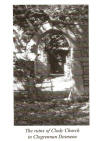-

- The graveyard entrance in
Clogrennan Desmene at Clody. Co. Carlow.
|

The old Clody Church (ruin) and graveyard are marked on the
OSi map and Cloydah village is off to the east.
Source:
http://map.geohive.ie/#
|

The old Clody Church (ruin) and graveyard are marked on the
Google street map. |

The Ruins of Clody Church
in Clogrennan Desmene. Co. Carlow |
Photo images from Carloviana 2010 page 87.
- A Topographical Dictionary
- of Ireland
by Samuel Lewis 1837
Cloydagh or Clody
also called Clogrennane, Co. Carlow
A
parish, partly in the
barony of Slievemargy, Queen's county, and partly in the barony
of Carlow, but chiefly in that of Idrone west, county Carlow, and
province of Leinster, on the river Barrow, which is navigable to
Waterford, 2½ miles (s.w. by s) from Carlow on the road to
Leighlin-bridge; containing 1422 inhabitant’s, and comprising
4737 statue acres, of which 290 are Woodlands, and 3764 acres are
applotted under the tithe act and valued at f3774 per annum.
The state of agriculture is very good, limestone abounds,
and is applied both as manure and for buildings: there are
limekilns on a large scale, the produce of which is chiefly
conveyed into counties of Wicklow and Wexford. Coal also
abounds, and is worked extensively. Sessions are held quarterly
at Milford. Here are extensive corn-mills and malt-kilns, in
Which about 100 persons are employed. The principal seats are
Clogrennan Castle, the residence of Col. Rochford; Milford, of
J. Alexander, Esq.; Fonthill, of W. Fishbourne, Esq., and Lenham
Lodge, of Capt. Butler.
Clogrennan was formerly an
estate of the Dukes of Ormonde. and gave the title of baron in
the Irish peerage to the Earls of Arran. The castle was taken by
Sir. Peter Carew, 1568, from Sir. E. Butler, who was then in
rebellion: in 1642 it was besieged by the Irish but was relieved
by Col. Sir. P Wemys; and here the Marquess of Ormonde mustered
his forces prior to the battle of Rathmines.
The ruins,
overgrown with ivy and forming a remarkly picturesque object,
yet exist, together with the remains of an old church, near the
present house, which is approached through one of its gateways.
The grounds, which are very beautiful are bordered on the west
by the mountains of the Queen's county, the sides of which are
clothed with wood to a considerable height, and on the east by
the course of the Barrow, adorned by several well-wooded islets.
On the Bawn-Ree, Jas. II. Encamped after his defeat at the
battle of the Boyne. Some curious relics of antiquity, including
brazen swords and arrow-heads, were found in a ford across the
Barrow, about 1¼ mile distant, in 1819. The living is a
vicarage, in the diocese of Leighlin, and in the patronage of
the Bishop; the rectory is impropriate in Col. Bruen and W.
Fishbourne, Esq.
The tithes amount to £276. 18. 5‘/2.,
of which £92. 6. 1s. Is payable to the vicar, and the remainder
to the lay impropriators. The glebe-house was built by a gift of
£400 and a loan of £360 from the late Board of First Fruits, in
the 1813; the glebe comprises six acres, subject to a rent of
£4. 4s. per acre. The church, a plain neat edifice in good
repair, was built by aid of a gift of £500 from the same Board
in 1803, and to the repairs of is the Ecclesiastical
Commissioners have recently made a grant of £167. 5.11. In the
R.C. divisions this parish is in the union or district of Old
Leighlin, and has a chapel. Besides the parochial school, there
is one in the chapel-yard at Ballinabranna; the number of
children in these schools is about 150; and in a hedge school
are taught about 90 children. The ruins of the old church are in
the demesne of Clogrennan; the cemetery is still used.
Source: Carloviana 2010
page 87.
The following is from the 'Archaeological
Inventory of County Carlow.' p. 65 & 89:
Medieval Ecclesiastical Sites
547
CLOGRENAN OS 7:13:1 (61,131) 'Church (in ruins),
Graveyard' OD 300-400 26875,17295 Church and graveyard
Undifferentiated late medieval parish church of Cloydagh.
According to ITA Survey (1945), church attached to Augustinian
Monastery of Great Connall, Co. Kildare.
Remains consist of
rectangular church (ext Dims 19.3m x 7.10m), of limestone rubble
with granite quoins. Church has opposed N and S doorways and
late medieval window with pointed arch of chamfered granite.
Plain window in S wall of chancel. May incorporate parts of
earlier structure, suggested by blocked narrow lintelled ope in
N wall close to W end. Door in S wall formerly included face
mask with bulbous features (possibly modern) on W jamb; arch and
jamb now removed. Piscina with moulded granite surround at E end
of S wall. Incorporated in W gable is stone with incised cross,
of pre-Norman date. 7:39 15-1-1992
Please report any images or links which do not open to
mjbrennan30@gmail.com
The information contained
in these pages is provided solely for the purpose of sharing
with others researching their ancestors in Ireland.
© 2001 Ireland Genealogy Projects,
IGP TM By
Pre-emptive Copyright - All rights reserved
TOP OF PAGE
|